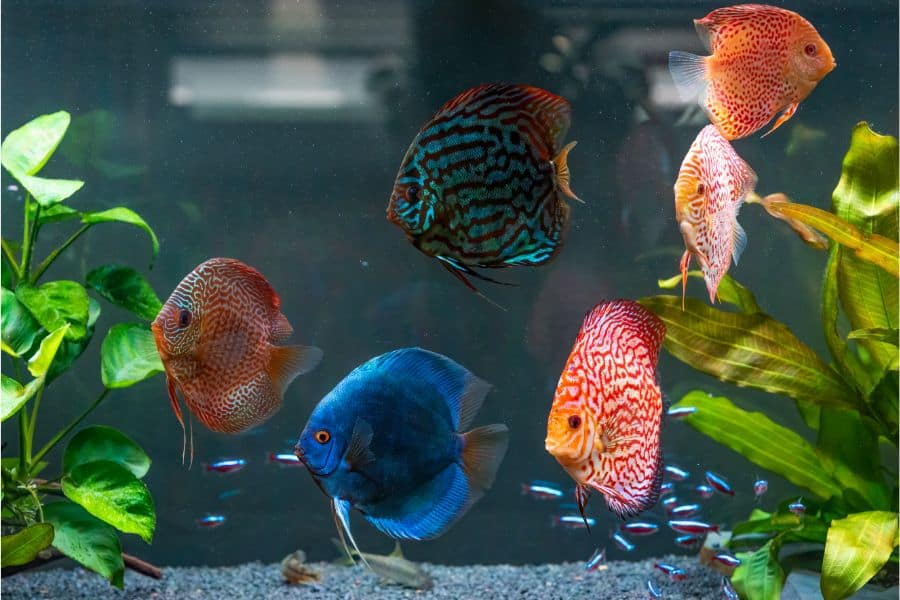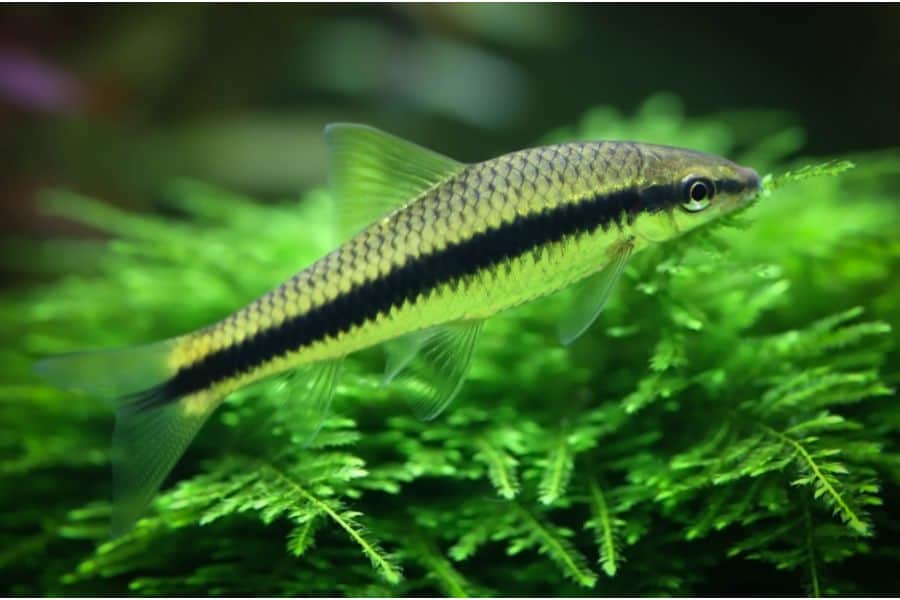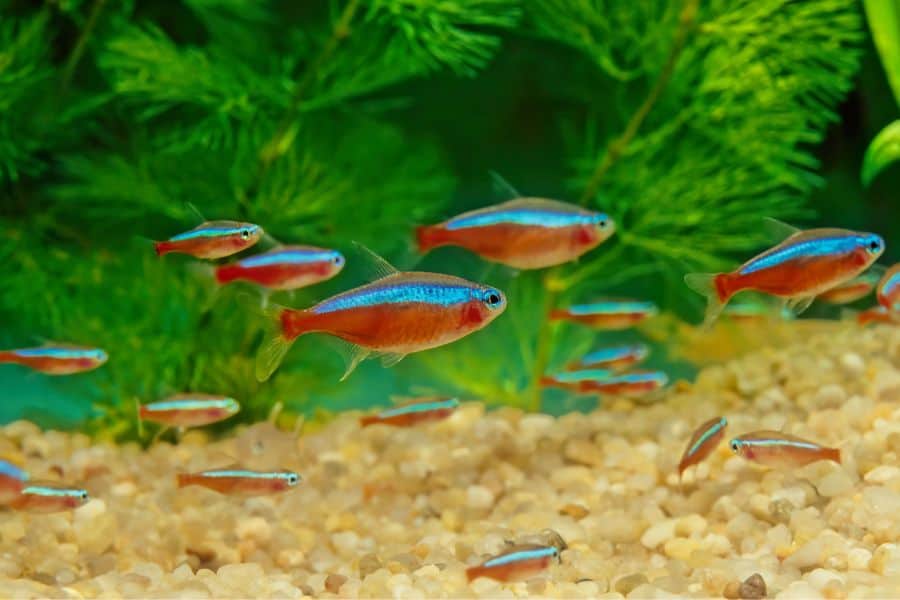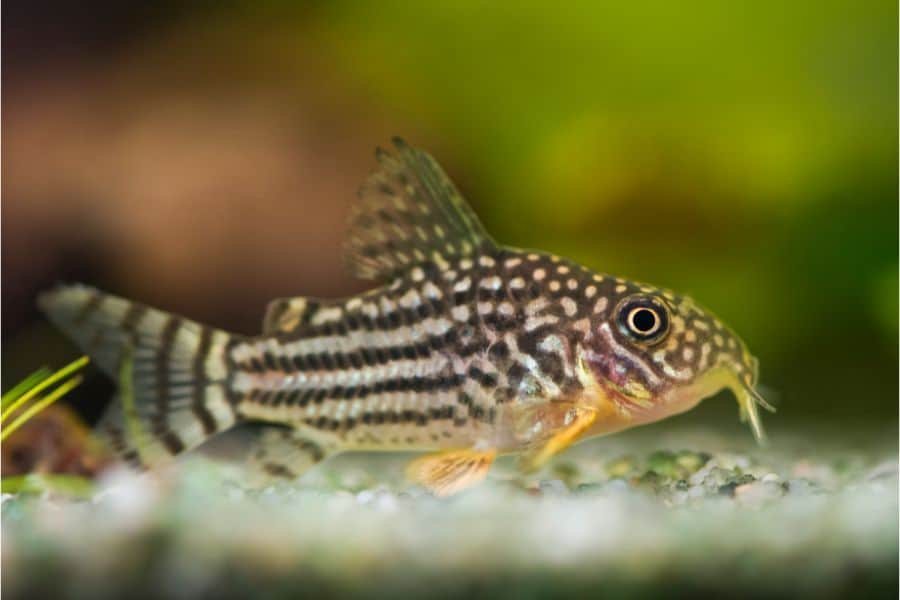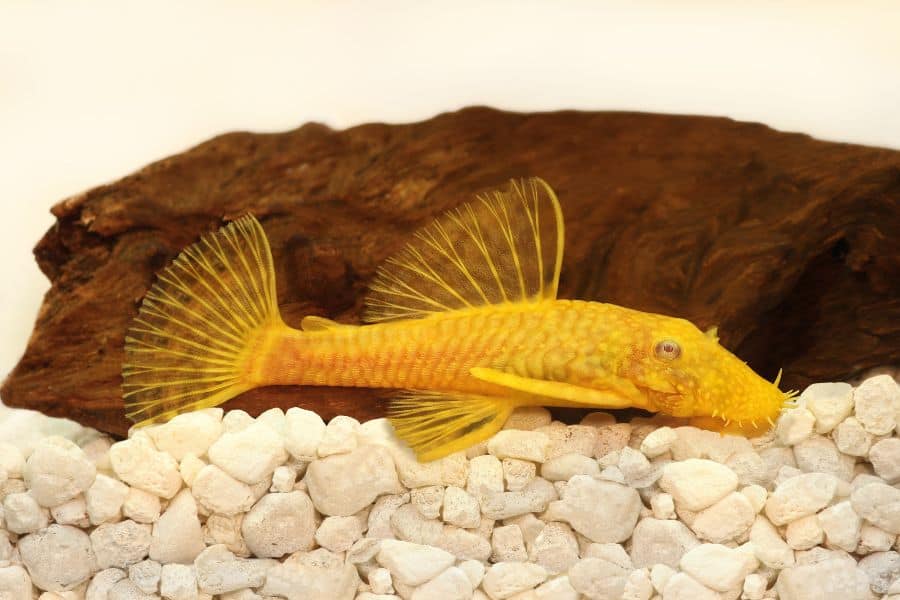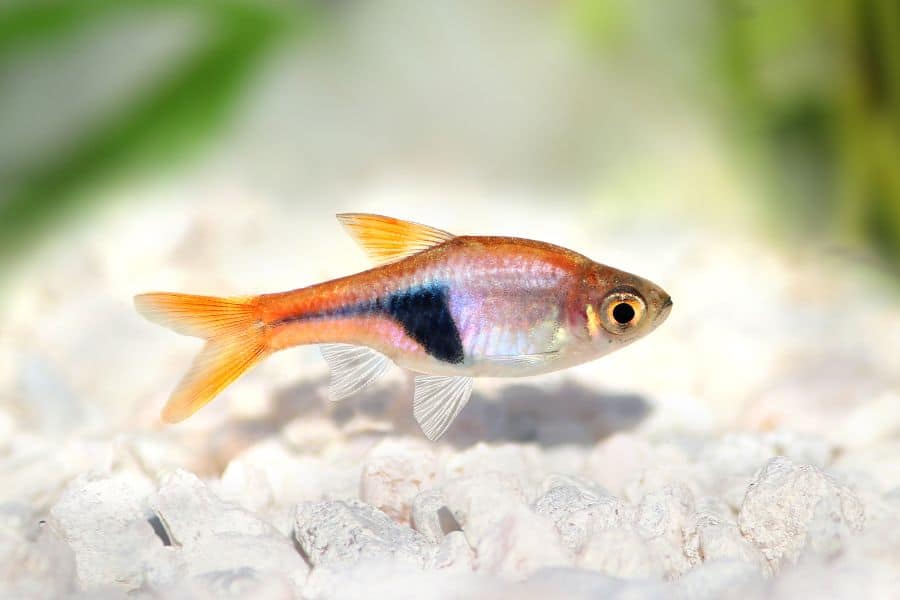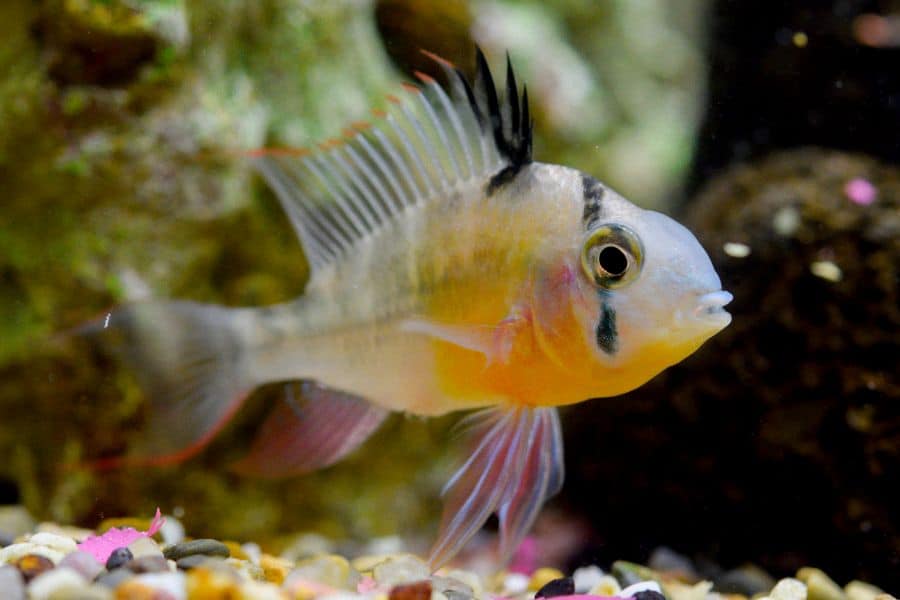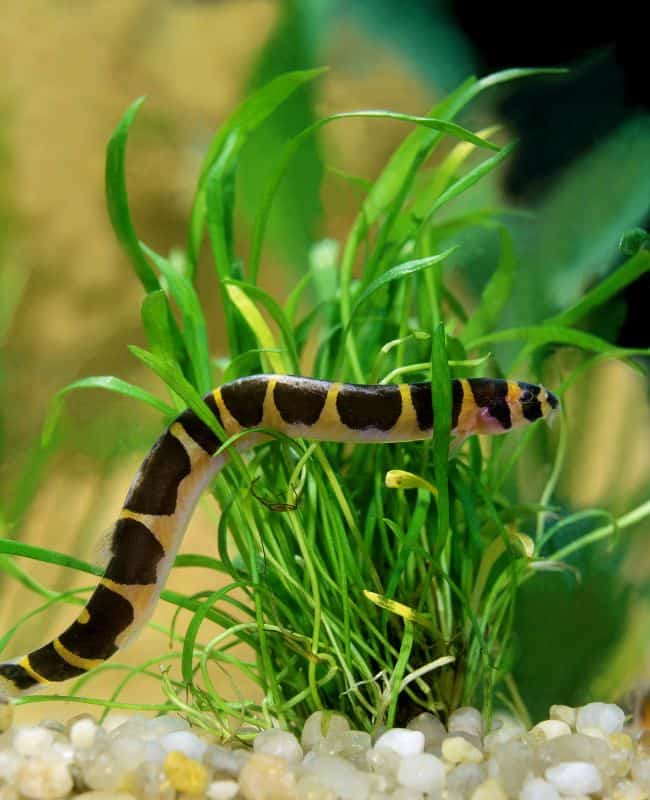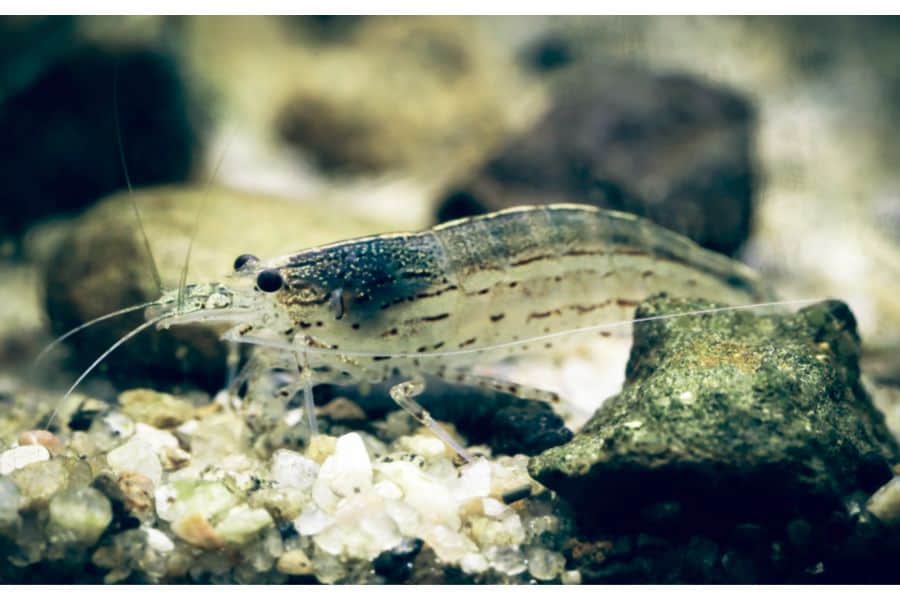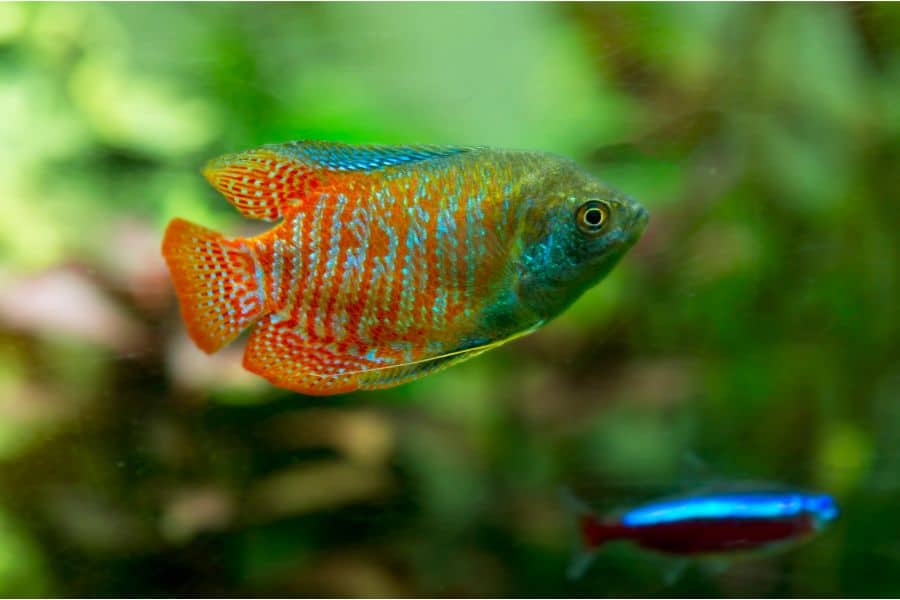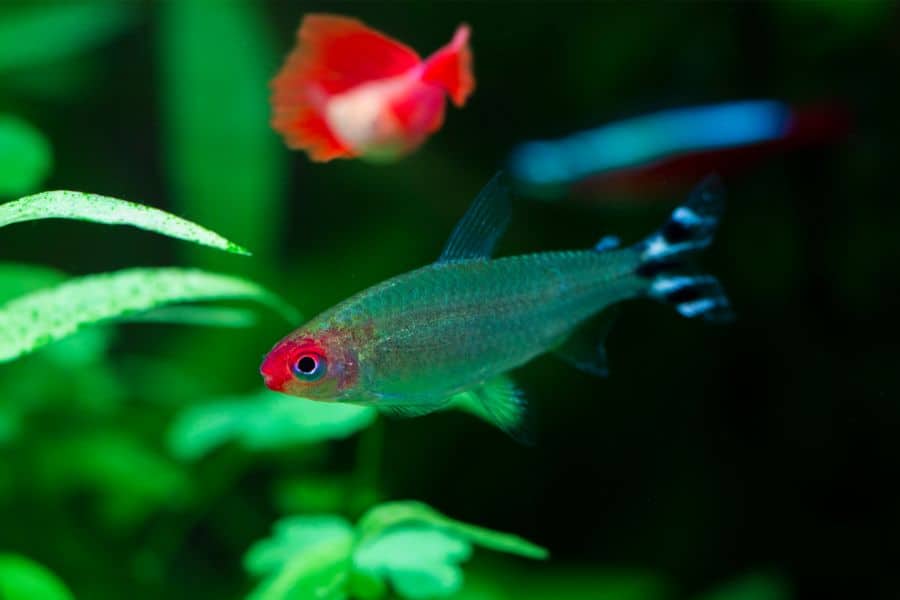Discus are one of the most beautiful fish you can own, even more so when paired with a stunning setup and the right tank mates. But, as discus are notoriously sensitive to water quality, you need to choose their roommates carefully.
That’s why we’ll be covering some of the best discus tank mates so you can find out which fish work well in your discus setup. Let’s dive in!
What Makes an Ideal Tank Mate for Discus?
Choosing the right tank mates for a discus tank is no walk in the park – you can’t just throw in any freshwater fish in your aquarium and expect things to go swimmingly! That’s primarily because of how difficult discus fish are to keep, even for the most experienced aquarist.
But that’s not to say it can’t be done! Below are some things you should keep in mind to help you pick the ideal roommates for your discus.
Water Parameters
Discus are highly sensitive to water quality, so there’s little room for error when it comes to parameters. Just a minor fluctuation in water chemistry can be lethal to these fish, which is why keeping the species with other fish can be challenging.
You just need to make sure the fish have the same water preferences as your discus fish. The ideal pH range for this cichlid species is between 6 and 7 with a hardness of approximately 2 dKH.
Discus require a warmer water temperature than the majority of other tropical fish species – between 80 to 85°F. The fish is native to the Amazon River basin, so it’s worth opting for tank mates that also originate from this area or similar climates as they will have more compatible water requirements.
Temperament
Despite being cichlids, a species well-known for its aggressive tendencies, discus are fairly peaceful creatures. They are not normally hostile to other fish, though they can be territorial during the spawning season, particularly towards other discus.
Due to their passive nature, you should choose non-aggressive fish that won’t chase or bully your discus. Schooling species such as cardinal tetras and bottom dwellers like cory catfish are both great options, but you could also opt for some larger fish like the clown loach.
Tank Size
While discus are flat and slender fish, they are not a small species by any means. These fish can weigh between 150 and 250 grams and grow up to 9 inches in length (though the average size is between 4.6 to 6 inches).
As a result, discus need at least a 75-gallon aquarium to explore – tall tanks are preferable due to their laterally compressed body shape. This is the minimum tank size for a small group of discus, but you’ll need to use a larger aquarium to accommodate tank mates.
Although not a golden rule, the “one inch of fish per gallon” rule is useful for calculating the number of fish you can house in a community setup.
Best Discus Tank Mates
1. Siamese Algae Eater
- Scientific Name: Crossocheilus oblongus
- Temperament: Peaceful
- Size: 6 inches
- Origin: Southeast Asia
The Siamese algae eater makes an excellent roommate for a discus tank due to their passive temperament and bottom-dwelling antics. They originate from Southeast Asia, including Thailand and Malaysia, where they are found in small rivers and streams.
Although nowhere near as graceful or vibrant as discus, Siamese algae eaters make great additions to a community setup as they will munch on algae, leftover fish food, and decaying plants and fish.
They are slim and torpedo-shaped with a silvery base color and a horizontal black stripe that runs along the center of their body.
They grow to around 6 inches in length and are most active in the lower portions of the tank, which means they will very rarely bump into your discus (and also won’t outcompete them for food!).
2. Cardinal Tetra
- Scientific Name: Paracheirodon axelrodi
- Temperament: Peaceful
- Size: 2 inches
- Origin: South America
While most tetra species are ideal tankmates for discus, the cardinal tetra is a particularly good choice as their vivid red and blue hue complements the discus’ equally colorful appearance.
They’re native to South America where they inhabit blackwater streams and tributaries. The cardinal tetra is a small fish that normally reaches a maximum length of 2 inches. They are torpedo-shaped with a metallic sheen to their bright blue and red coloration.
Like many tetra species, cardinal tetras prefer to be kept in groups of at least 6. A spacious discus aquarium could easily accommodate a larger school, so the more, the merrier!
Cardinal tetras are completely peaceful and usually occupy the mid-section of the tank, so they are ideal candidates for a discus aquarium. Better yet, they can tolerate the higher water temperature needs of discus fish.
3. Sterbai Corydoras Catfish
- Scientific Name: Corydoras paleatus
- Temperament: Peaceful
- Size: 2.5 inches
- Origin: South America
Corydoras catfish are one of the most affable fish you can come across. This makes them a popular choice for freshwater community aquariums, including those that house discus.
Native to South America, cory catfish are found in fast-moving streams and rivers. They are bottom dwellers who spend the majority of their time scavenging for food with their whisker-like barbels.
There are many different species in the cory catfish family, all of which can work well in a discus setup, but the sterbai cory is perhaps the most commonly kept species. This pretty fish has a dark brown body decorated with white spots. It normally grows to between 2 to 2.5 inches in size.
Sterbai cory cats need to be kept in groups of at least 4 as they enjoy the company of their own kind. Although they will consume leftover fish food and decaying plants or fish, you’ll still need to supplement their diet with other sources like sinking catfish pellets, vegetables, and live or frozen fish foods.
4. Clown Loach
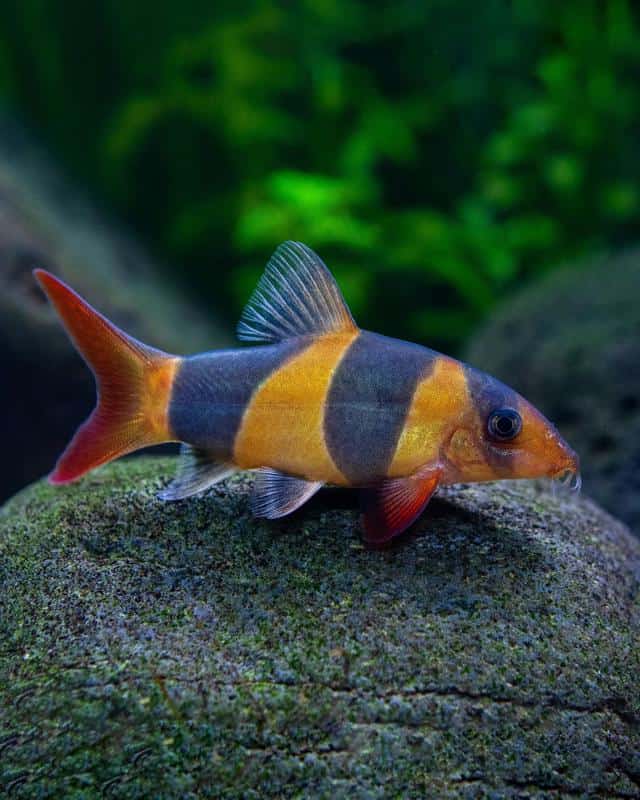
- Scientific Name: Chromobotia macracanthus
- Temperament: Peaceful
- Size: 6-12 inches
- Origin: Indonesia
The clown loach is one of the best discus tank mates as they are docile, colorful fish that spend a large portion of their time at the bottom of their tank.
Like their name suggests, the clown loach features a bright orange body with bold black stripes (normally with white edges). They can grow anywhere from 6 to 12 inches, though most specimens are around the 8-inch mark.
Clown loaches are schooling fish, so you’ll need to keep them in groups containing at least 5. Although a small group can live in a 75-gallon tank as juveniles, they will need at least 150 gallons of space as adults.
The species are shy by nature and enjoy scavenging through the substrate, which makes them the perfect fit for a discus tank. Be sure to feed them a varied diet of sinking fish pellets/flakes and live or frozen foods, alongside some fresh veggies.
5. Bristlenose Pleco
- Scientific Name: Ancistrus cirrhosus
- Temperament: Peaceful
- Size: 3-5 inches
- Origin: South America
Native to the fast-flowing waters of the Amazon River basin in South America, the bristlenose pleco is a weird but wonderful fish that makes a solid companion for discus.
They get their name from the fleshy, whisker-like appendages around their nose – males typically have more of these bushy whiskers, which is one of the easiest ways you can tell sexes apart.
They’re available in many different colors such as red, albino, and calico, but the most commonly sold variety of this catfish is brown/olive with off-white spots.
Despite their intimidating appearance, bristlenose plecos are quite skittish. They are nocturnal and very rarely show aggression to other fish, though males can be territorial towards other plecos and bottom-dwellers.
The bristlenose pleco is mostly herbivorous, so the majority of their diet should include plant matter. They can be offered fresh algae, algae wafers, and vegetables like zucchini and cucumber. Make sure you have a piece of driftwood in your tank as plecos need wood in their diet for digestion.
6. Harlequin Rasbora
- Scientific Name: Trigonostigma heteromorpha
- Temperament: Peaceful
- Size: 1.75-2 inches
- Origin: Southern Thailand, Sumatra, Malaysia, & Singapore
Another one of the best discus tank mates is the harlequin rasbora, a small but attractive fish that originates from Sumatra, Malaysia, southern Thailand, and Singapore.
Reaching between 1.75 to 2 inches in size, harlequin rasboras are coppery red with a black patch that covers the back half of their body. They prefer to live in schools, so you should keep a minimum of 6 in your discus tank.
Although they occupy the same level in the tank as discus (middle to upper region), harlequin rasboras will not trouble your discus. In fact, they make fantastic dither fish that help keep the peace in a community setup!
7. Bolivian Ram
- Scientific Name: Mikrogeophagus altispinosus
- Temperament: Semi-aggressive
- Size: 3-3.5 inches
- Origin: Bolivia & Brazil
The Bolivian ram almost matches the beauty of the discus fish, making them a stunning choice for your community aquarium. They’re native to shallow freshwater waters in Bolivia and Brazil.
Although cichlids, the Bolivian ram is relatively passive if they are housed in groups to spread out aggression. That being said, you should always keep an eye out for fighting among these fish so you can separate them if necessary.
Bolivian rams are oval-shaped with a striking pearly white body and rayed fins that can either be yellow, orange, red, olive, or black around the edges. They are fairly small, only reaching around 3 to 3.5 inches in size.
As mentioned above, Bolivian rams should be kept in groups, ideally at least 6 or 8 to prevent territory disputes.
8. Kuhli Loach
- Scientific Name: Pangio kuhlii
- Temperament: Peaceful
- Size: 3-5 inches
- Origin: Indonesia
The kuhli loach is a good fit for any freshwater community tank due to their gentle disposition, so they’ll easily get along with discus. They have a long, eel-like body that is yellow/orange with brown/black bands.
Kuhli loaches are bottom-dwellers that enjoy sifting through the substrate for food, so they will seldom come into contact with your discus. They can be very skittish, more so when kept alone – try to keep them in groups of at least 4 to boost their confidence!
These fish can be a little sensitive as they are scaleless, so good water quality and stable water parameters are a must. They are most active at night, preferring to remain hidden during the day.
For this reason, make sure your tank has plenty of hiding spaces and thick vegetation. It’s also best to use a soft substrate like aquarium sand to allow them to dig and prevent any damage to their delicate barbels.
9. Amano Shrimp
- Scientific Name: Caridina multidentata
- Temperament: Peaceful
- Size: 2 inches
- Origin: Japan & Taiwan
If you’re looking for a great roommate for your discus that will also help keep your aquarium clean, look no further than the amano shrimp! They’re found in freshwater swamps in Japan and Taiwan and are one of the larger species of freshwater dwarf shrimp.
Growing to 2 inches in size, amano shrimp will be a less tempting snack to your discus than other types of dwarf shrimp. A heavily planted tank with lots of hiding spaces will make it much harder for your shrimp to be preyed on, though you may still lose the odd one.
Amano shrimp aren’t the most exciting creatures in terms of appearance (they’re transparent with brown/red dots or dashes along their sides), but they are very beneficial to your aquatic ecosystem.
They’ll help keep your tank clean by feeding on algae, decaying fish/plant matter, and leftover scraps, so they’re a handy critter to have around!
10. Malaysian Trumpet Snail

- Scientific Name: Melanoides tuberculata
- Temperament: Peaceful
- Size: 1 inch
- Origin: Southern Asia & northern Africa
Alongside the amano shrimp, the Malaysian trumpet snail (or other aquatic snail species) is a valuable cleanup crew member. This makes them a helpful invertebrate to have in your discus tank as they will graze on algae, dead plants or fish, and uneaten food.
Better yet, these creatures burrow into the substrate, which helps prevent gas toxic buildup and enables plant growth!
As you might have already guessed from their name, Malaysian trumpet snails have long cone-like shells. They come in a wide range of colors and patterns, including brown, cream, and gray.
They have similar water preferences to discus as they originate from southern Asia and northern Africa. While they can survive on food already present in your aquarium, you should supplement their diet with vegetables, bottom feeder tablets, and pellets.
11. Dwarf Gourami
- Scientific Name: Colisa Lalia
- Temperament: Peaceful
- Size: 2-4.5 inches
- Origin: India, Assam, Bangladesh, & West Bengal
The dwarf gourami is an incredibly beautiful fish with a peaceful temperament, making them one of the best fish to keep with discus. Endemic to Assam, Bangladesh, West Bengal, and India, this labyrinth species can breathe oxygen from the water’s surface, just like betta fish.
Males are more vibrant than females and can be shades of neon blue, red, and orange. Females, on the other hand, are much paler and have a silvery undertone.
The dwarf gourami is a fairly small fish that can grow between 2 to 4.5 inches in size, with females being on the lower end of that scale. They are slow-moving and non-aggressive, though males can be territorial with other males.
Although they are social and prefer to be with their own kind, you’ll need to keep more females than males to prevent fighting (a 1:2 ratio is ideal).
12. Rummynose Tetra
- Scientific Name: Hemigrammus rhodostomus
- Temperament: Peaceful
- Size: 2 inches
- Origin: South America
Last but not least is the rummynose tetra, a pretty little fish that shares the same water preferences and temperament as discus! Native to South America, the rummynose tetra grows to a maximum size of 2 inches and features a gorgeous bright red nose (hence the name!),
Like discus, rummynose tetras can be sensitive to water parameters – a well-maintained and established tank is essential to keep them healthy. Interestingly, when rummynoses are stressed or sick, they lose the red coloring on their nose.
Rummynose tetras are schooling fish, so you need to keep them in numbers of at least 6. This is particularly important for this species as they are prone to illness/disease if they are unhappy with their environment.
12. Bala Shark
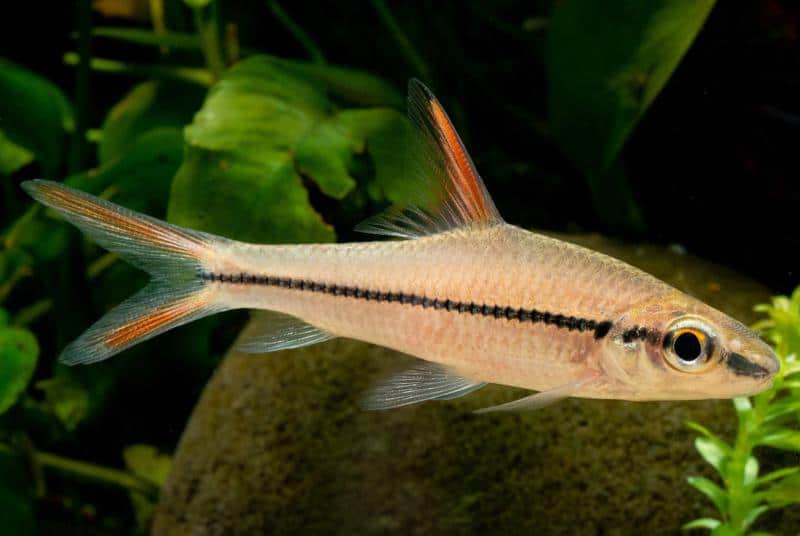
- Scientific Name: Balantiocheilos melanopterus
- Temperament: Peaceful
- Size: Up to 14 inches
- Origin: Southeast Asia
The bala shark is a favorite among aquarists due to their striking shark-like appearance. But, unlike actual sharks, they are relatively peaceful and skittish fish, making them a solid tank mate for discus.
While not “true” sharks, Bala sharks look pretty close to the real deal with their pointed fins and shimmery metallic bodies. They can grow extremely large, often up to 14 inches in length, so you’ll need a big aquarium to accommodate their size and energy.
In addition, Bala sharks prefer to be kept in groups of at least 4, meaning you’ll require a minimum of 100 gallons to keep a small shoal with discus. However, bigger is always better with these fish due to their high activity.
Read More:
Final Thoughts
It takes a lot of work to set up the ideal habitat for discus as not only do you need to keep your aquarium meticulous, but you also need to select your inhabitants wisely. But, as any discus owner will tell you, it’s well worth the time and energy!
Hopefully, this guide helped you choose some of the best discus tank mates and what makes the ideal roommate for this elegant species.
